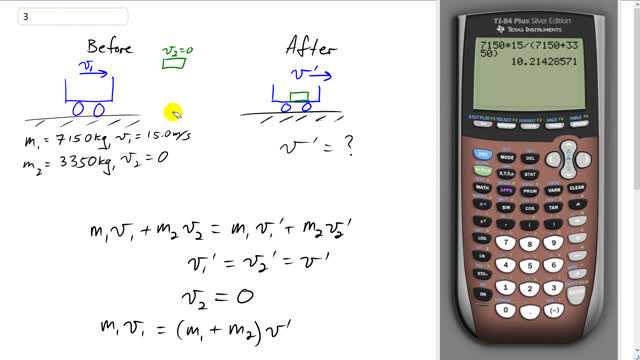
A 7150-kg railroad car travels alone on a level frictionless track with a constant speed of 15.0 m/s. A 3350-kg load, initially at rest, is dropped onto the car. What will be the car’s new speed?

In order to watch this solution you need to have a subscription.
This is Giancoli Answers with Mr. Dychko. This train car is moving down this frictionless track at a constant speed of 15 meters per second and I have written down all the information we are given here; this mass of this train car, we'll call that mass 1, 7150 kilograms, and this other mass here is just hovering above the track not moving and it's gonna get dropped into the car just as this rail car passes underneath right here— it's gonna have this block dropped into it— and then it will be traveling together with the block at some unknown speed that we have to figure out after this block lands inside and this block has a mass of 3350 kilograms. So we can start by saying that momentum is conserved, which is always true, so we have mass 1 times velocity 1 plus mass 2 times velocity 2 equals m 1 times v 1 after collision or after the block was dropped plus m 2v 2 prime. Now v 1 prime and v 2 prime, let's just call it v prime; there's no need for a subscript 1 or 2 because the masses are both together moving as one so there we go. v 2, initially, I just wrote down here a zero so that means this term disappears— this block is not moving initially. So we have m 1v 1 equals m 1 plus m 2 factored out multiplied by this common v prime since there's no need for subscripts anymore as I was saying since they are stuck together; it's always true for an inelastic collision where, after the collision, the two objects stick together, you can say that the velocity afterwards is just one common after-collision velocity—no need for subscripts. Okay. So we'll solve for v prime by dividing both sides by the sum of the masses and then we get v prime is m 1v 1 divided by the total mass. So that's 7150 kilograms times 15 meters per second divided by 7150 kilograms plus 3350 kilograms which gives 10.2 meters per second is the final velocity of this combined rail car and block.
The video is not playing. Is has an X Instead of a > play sign.
Hi Joel,
Thank you for reporting this. I hope the issue resolved quickly. Sometimes reloading the page sorts this out, or other times trying a different web browser is the fix. If you want to share any other details, such as what fixed the problem, I would be very interested.
All the best,
Mr. Dychko